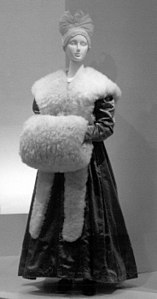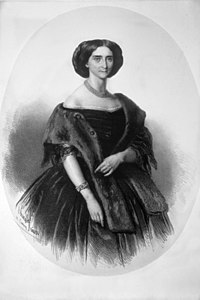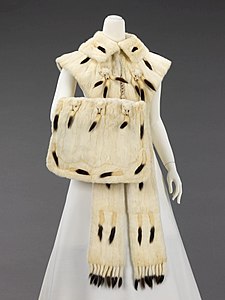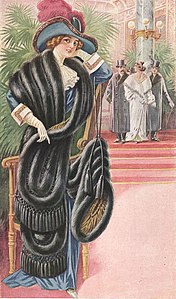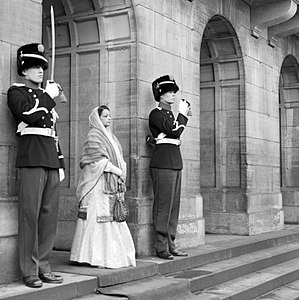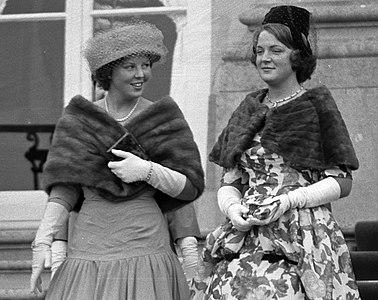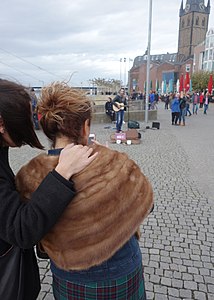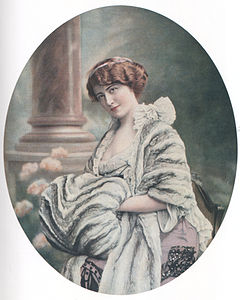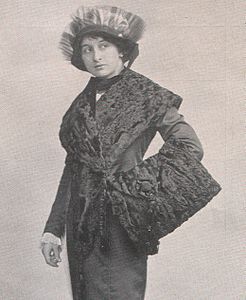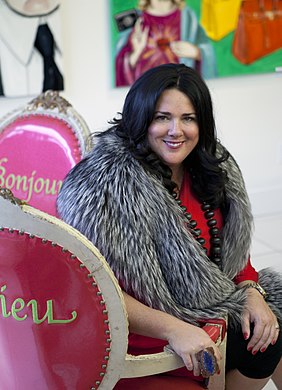Fur stole

A fur stole , or simply stole or stolacape , is a women's garment made from fur . It covers the back and shoulders like a cape and runs smoothly over the chest in front. A similar item of clothing that covers more of the upper body and arms is a short fur cape. Like the different shapes, the terms fur stole, fur scarf, fur tie , fur necklace , fur cape , fur cloth - and others - are fluent and cannot be clearly distinguished from one another.
Mostly, until the end of the 20th century, fur stoles “are used as a valuable accessory to evening dress ”.
design
In linguistic usage, a distinction is not always made between a cape-like fur stole and a straight, generously cut fur scarf. In contrast to the scarf, the cape-like fur stole is slightly rounded, is worn closer to the neck and is often adapted to the shape of the shoulder so that it cannot slip. In the textile industry, on the other hand, a stole is understood to be a large, shawl-like shawl.
In 1973, the fashion journalist Marie-Louise Steinbauer gave advice on who, when and how to wear a fur stole: “When she goes out in the evening, to the theater, to a concert, to a restaurant, the ladylike woman doesn't want to miss a fur accessory . Stoles are ideal for them: they warm the shoulders and decorate the wearer while sitting. But dealing with them needs to be trained. Queen Wilhelmina of the Netherlands is the best example of how not to do it. The fur lies over her shoulders like a foreign body, does not move, does not flatter or envelop. The secret of the successful Stolat wearer lies in the fact that she carefully controls her effect in front of the mirror. […] It is only important, as the rule of thumb says, that a stole should always be worn higher than the waist mark. Wide skirts and a drooping shoulder damage the figure and its overall appearance. ”Queen Wilhelmina, scolded by Marie-Louise Steinbauer, was, like her daughters, a great fur lover with a rich fur wardrobe. If she wore a stole, it was usually made of lush silver fox fur in the shape of a fur necklace, which is more difficult to put on.
history
The stole of the Roman costume, a long dress that was worn over the tunic , has little in common with the stole of modern times. What they have in common with the fur stole, however, is that the lower edge, along with leather, was mostly made of fur.
Towards the end of the 19th century there was hardly any fur clothing worn with the hair facing outwards, but together with the introduction of the fur sewing machine it soon began to take hold on a large scale. In the western world, sets of smaller pieces of fur made of the same fur were already particularly fashionable around this time, and combinations of ermine fur were particularly noticeable. To set one could Busby are usually a fur muff , and sometimes fur gloves and almost always a small fur tie or a larger fur scarf. Ermine scarves and ties were usually adorned with the black-tipped tails of the ermine fur, and small "plastered heads" were often added. In 1913 it was also said: “For the toilette d'aprés midi and suitable for the winter season for the Cote d'Azur , nothing is more up to date than a long stole with a matching mink muff , edged with a lace”. From the rather smaller town of Frankenberg in Saxony, it was reported in 1895 that a fur boa was no longer bought with the fur trim, but a fur boa.
At the time, these small fur parts were the most striking item of the fashion accessories grouped under the term “accessories”. In those years in particular, it was sometimes difficult to differentiate between a stole, then also known as an “etole”, and a tie like between a stole and a cape (which in turn turned into a proper cloak). In the 1950s, an Austrian fur lexicon differentiated between a stole and a stole cap. According to this definition, the shape of a stole was more in line with the liturgical garment : “A band of fur, once the same width, then again widening towards the ends. But also called Fuchs animals [ Fuchskolliers ] fox stoles. " Around this time, shoulder collars and capes, which were simply worn over street costumes, became increasingly rich with evening dresses.
It was striking, as the Italian fashion journalist Anna Municchi wrote, that Muff, who was so popular at the time, had a loyal companion, the stole: “It was a long-lasting, persistent friendship, they almost never separated, they were always connected in harmony, and together they made the final touch of elegance. Together they widened or shrank, not just content with fur, they decidedly went in search of other decorations, and as the years went by they became more and more elaborate. - Already in the catalog Alla Città di Mosca , winter 1905/1906, they sported tails, buttons and trimmings tassels ; they were already daringly outlined with little animal heads and alternately edged with lace and fur. The stole could widen up to over the shoulders, remain narrow or be enriched with a small collar. The same model was able to get a wide selection of fur or lapels that stretched from Persian to mink, from untreated beaver to ermine, gewellthaarigem Karakul Astrakhan to otters , etc., with a few side trips to Australian opossum to with white or black Mongolian lamb to end. - Over the years tails and heads seem to have multiplied in some kind of evangelizing mystery, there were eighteen on a sable marble , six heads on the front of the stole including the clip and six on the back, three and three on the muff. - In the end the stole changed its shape: no longer rounded, it became rectangular with a triangular back, covering the hips, the furs sewn together in a square shape. - Fuchs was in great demand and the space between one fur and another was emphasized by a small silk frill. "
Fur stoles in the second half of the 20th century were much simpler. As a rule, no decorative accessories were used. The classic among the elegant, especially evening-festive stoles is still the multi-skin, exuberant mink stole, generously covering the shoulders and ending straight or rounded above the waist.
Dorothea von Sagan
(early 19th century)Vogel fur stole and -muff
(British, about 1825)Opera singer Rosa Csillag
(around 1860)Princesses Beatrix (left) and Irene of the Netherlands with stole and cape
(1960)Princess Margriet of the Netherlands with a mink stole
(1967)Assessment of a mink stole at the Frankfurt fur fair (2008)
Types of fur
In the past, fur stoles were essentially only used in soft, flattering types of fur in hair and leather. Varieties with tight or stubborn hair were not used. Since fur capes are especially worn for special social events, high-quality furs are preferred, limited by the respective assets of the wearer or, as is usually the case, of the partner giving the gift. The reasonably priced rabbit fur , which is otherwise used everywhere, was rarely found, if so, then as an imitation of more valuable types of fur. At the top are sable and chinchilla . Mink fur, which has been the main material used for fur stoles since the 1950s, is more common and a little less precious. In general, the mink is to be narrower strips of fur in the length of the half stole omitted , which gives it a very elegant appearance to the public's sense. The feudal and ermine skins, which were previously reserved for the nobility and high dignitaries , were also used to make stoles, capes and shawls for evening and summer evenings. Despite the high value at times, spotted skins such as ocelot , leopard or wild cat skins were probably not made into stoles, nor was the hamster skin, which was also very vividly patterned .
The fabric-like, fine broad-tailed fur was mostly worked into triangular cloths and other shapes that could be described more as cloth. The outer edge often formed a band of plaited trimmings. Long-haired stoles were mainly made of silver fox , white fox and other noble fox species , and until the 1940s also made of skunk fur . The light back stripes of the skunk's fur were removed or the already black fur was additionally colored black. There were cheaper designs from imitations of these skins through cheaper types of fur, for example " refinements " of rabbits or red foxes .
Skins of various bird species
(around 1840)Chinchilla
( Jeanne Paquin , 1903)Sealbisam
(1913)Persian Claw
(1913)Arctic Fox
(1951)
processing

The most elegant processing of a stole for the appearance is considered to be omission, in which the shape of the fur is changed to narrow strips in the length of half the pattern. Not all types of fur are equally suitable for this; thick hair is a prerequisite and the fur must not be too small. However, some types of skins can be enlarged to what appears to be one skin by “cutting” several skins into one another before leaving them out.
The small white arctic foxes, which are densely matted in their hair, are enlarged by the so-called galloping and their coat is loosened. Here, narrow strips of leather are sewn into the leather without tearing the cohesive undercoat. After the development of special cutting devices, " air gallooning " has also been increasingly used for many other long hair skins since shortly before the turn of the millennium . With these devices, short, closely spaced cuts are made in the fur leather much more efficiently and with greater space gain than before, so that it can be pulled apart like a net. Fixed in this form, this results in a particularly soft case that adapts to the body, especially for stoles and scarves.
A specialist book from the GDR in 1970 points out that stoles are made exclusively of fine material and must therefore be treated with special care in order to keep them soft and flattering. The silk lining should also be “light and particularly adorn. This can be achieved either through the use of embroidered silks and borders or through lining decorations. In particular, lining ruffles, pouch pockets and decorative stitches are used. Furthermore, bumpers are used when feeding stoles. They support the hair at the edges, which creates a particularly broad effect and reduces repulsion ”.
In 1956, 8 furrier hours, 5 manual sewing hours and 5 machine sewing hours were estimated for the production of a silver fox stole from two skins.
Web links
Individual evidence
- ↑ a b Alexander Tuma: Pelz-Lexikon. Fur and Rough Goods, Volume XXI . Alexander Tuma, Vienna 1951, p. 190, keywords "stole", "stole tape" .
- ↑ a b Author collective: Manufacture of tobacco products and fur manufacture . VEB Fachbuchverlag Leipzig 1970, pp. 467–468. → Table of contents .
- ↑ Alfons Hofer: Textile and Model Lexicon . 7th edition, Volume 2, Deutscher Fachverlag, Frankfurt am Main 1997, p. 869, keyword “Stole”. ISBN 3-87150-518-8 .
- ^ Marie-Louise Steinbauer, Rudolf Kinzel: Marie Louise Pelze . Steinbock Verlag, Hanover 1973, pp. 167-168.
- ^ Wilhelmina picture collection of the Netherlands with fur .
- ↑ In: La Mode Pratique , January 16, 1913. Secondary source Anna Municchi: Ladies in Furs 1900–1940 . P. 72.
- ^ Albin König: The furrier in Frankenberg in Saxony . In: Studies on the situation of the craft in Germany with special consideration of its competitiveness compared to large-scale industry . Volume 2, Kingdom of Saxony , first part, Duncker & Humblot, Leipzig 1895, p. 325.
- ↑ Paul Larisch , Josef Schmid: The furrier craft . III. Part, self-published Paris, 1902, p. 25.
- ↑ a b Anna Municchi: Ladies in Furs 1900–1940 . Zanfi Editori, Modena 1992, pp. 67, 82-83 (English), ISBN 88-85168-86-8 .
- ↑ Eva Nienholdt: Fur fashions of the 20th century . In: Das Pelzgewerbe No. 5, 1957, Hermelin-Verlag Dr. Paul Schöps, Berlin et al., P. 215.
- ^ Author collective: Der Kürschner. Technical and textbook for the furrier trade. 2nd revised edition. Vocational training committee of the central association of the furrier trade (ed.), JP Bachem publishing house, Cologne 1956, p. 356. → Book cover and table of contents .

